Mammillaria bombycina is a tiny cactus which would live on any shelf. They produce offshoots which would arise from the base of the plant, and they would usually tend to form in cactus clusters
When you are interacting with the cactus and if you are wearing loose clothing, chances are that the hooks could catch you.
Having said that, it will not poke you though. They would produce blooms in brilliant pink.
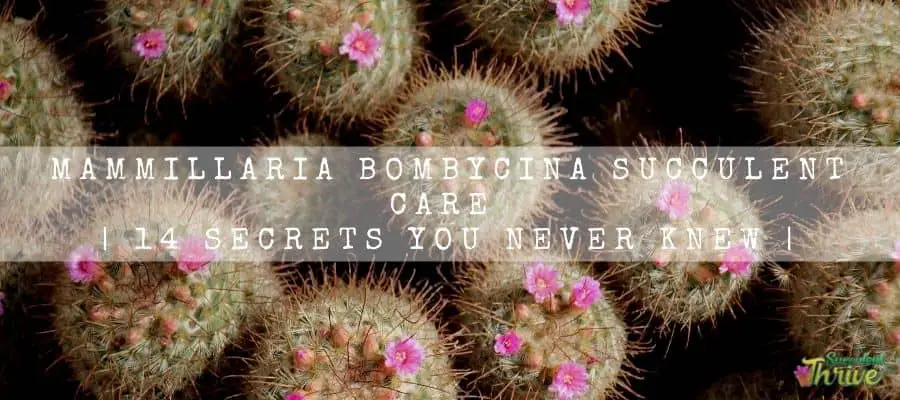
How do I identify a Mammillaria bombycina?
These are tiny cacti which would come up with densely packed colonies and they are about 20 cm in height.
They would further consist of tubercles which would tend to take a cylindrical or conical shape. They will not have any tips but they consist of woolly armpits.
Those areolas would consist of wool and about 30-40 radial spines. In addition to that they will have 2-4 central spines too.
These plants consist of spines, in white in color. Not only that but also, they carries a long hooked spine right in the middle as well.
In terms of flowering, they produce flowers in purple, and they are small in size. Further you could spot them forming right at the cactus’ top.
Apart from that they would produce a fruit which would contain small seeds. Those seeds are black in color.
Size
These cacti are small plants which would perfectly fit in for cute owl planters. You could place them anywhere, be it your office or somewhere else.
These plants would rise to 40 cm (15.75 inches) in general. In terms of diameter, it would be 20 cm (7.87 inches).
You could spot many of these plants as cylindrical, conical, round or even in pyramidal shapes.
Growth rate
Mammillaria bombycina would usually have a medium growth rate. However, you need to make sure that you are fulfilling its basic requirements for the proper growth.
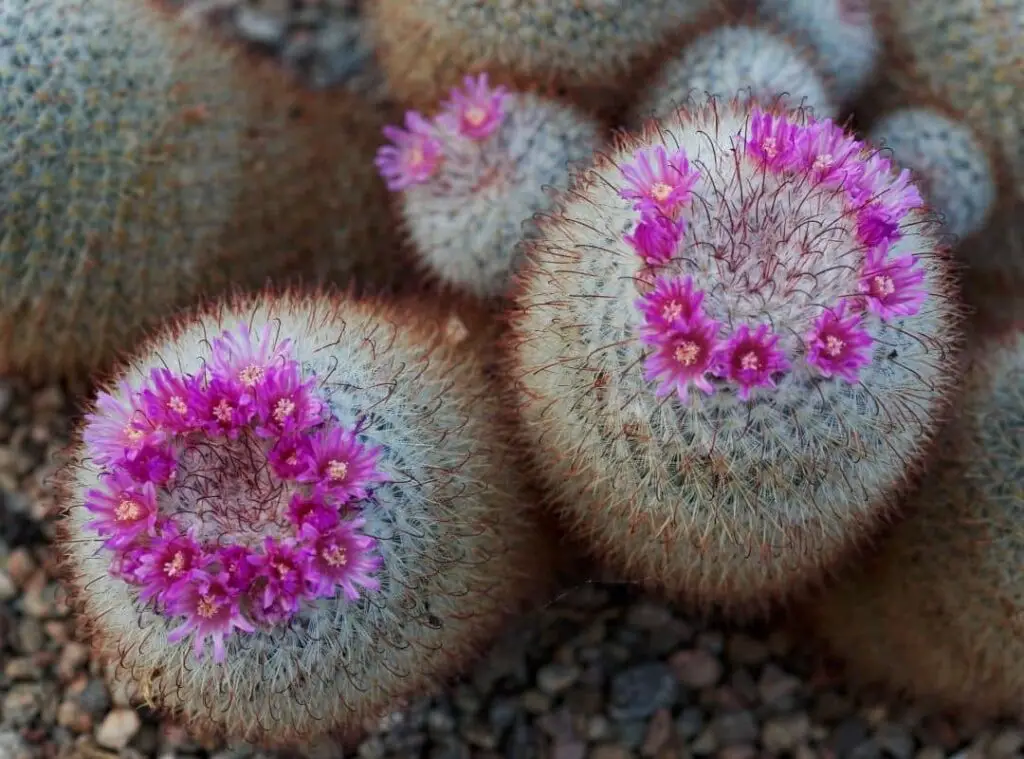
One look care guide
| Botanical Name | Mammillaria bombycina |
| Common Name | Silken pincushion cactus |
| Plant Type | Cactus |
| Mature Size | 40 cm (15.75 inches). In terms of diameter, it would be 20 cm (7.87 inches). |
| Sun Exposure | Full sunlight |
| Soil Type | Fast draining |
| Soil pH | Acid – Neutral – 5.0-7.0 |
| Bloom Time | Spring |
| Flower Color | Purple |
| Hardiness Zones | 9a to 11b |
| Native Area | Mexico |
| Toxicity | Nontoxic |
| Average price | USD 7-10 |
How do you take care of a Mammillaria bombycina?
It would be a little breezy when it comes to taking care of these cacti, particularly if you are a fresher in cactus gardening.
These cacti have adjusted to grow vigorously despite the harsh conditions they would face. In case if you are caring for them too much, chances are that it could be fatal on the plant as well.
Having said that you cannot keep the plant unattended for a long time.
Light Requirement
Mammillaria bombycina would prefer to grow under lots of sunlight. As such you need to make sure that you are providing them plenty of sunlight so that they can grow smoothly.
In case if you are growing the cactus in a low light area, you could consider growing them with a normal grow light.
As such, you need to make sure that you are providing the full sunlight Mammillaria bombycina require so that they can grow to their fullest.
In other words, you should always make sure that they are exposed to full day sunlight right throughout the year.
Temperature and humidity
Keep in mind that if you expose the Mammillaria bombycina to colder temperatures, that will have fatal repercussions on your beloved cactus plant.
The winter season could literally be a bad and hard season for them particularly if you have placed them outdoors.
As such if you have grown them outdoors, it is best to shift them indoors so that you could protect the plants from getting exposed to such conditions.
They would perform well in the temperature range of 10 degrees Celsius – 24 degrees Celsius (50 degrees Fahrenheit – 75.2 Fahrenheit).
In other words, Mammillaria bombycina are fond of warmer temperatures. On the other hand, Mammillaria bombycina will stay a little hardy if exposed to mild frosting conditions, however not for too long.
Is it cold hardy?
Mammillaria bombycina is Mildly frost-hardy plants.
USDA Hardiness Zone
Mammillaria bombycina would prefer to grow in USDA hardiness zones 9a to 11b
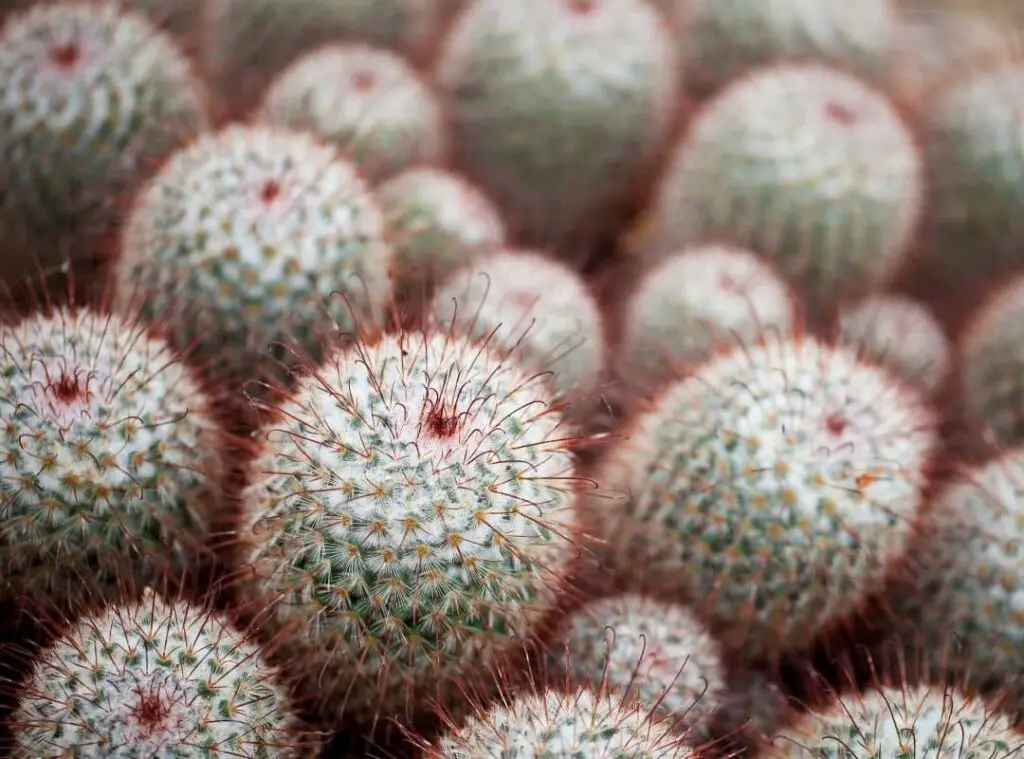
Watering Requirement
Just like with the rest of other succulents and with cacti, refrain from applying too much water for them. When you water, you should ideally wait until the top surface of the soil becomes dry.
You need to provide a fair time until the soil gets dry and only after that you could water them.
However, when you start watering them, Make sure that you are watering them thoroughly which would allow the soil to soak through with water.
Mammillaria bombycina would survive on minimum water. However, after you complete watering them, ensure that excess water would be draining through the draining holes without getting retained in the pot.
It is very crucial that you have enough draining holes for this purpose. When it comes to watering the Silken pincushion cactus during the winter season, you need to skip watering them at all.
If you are unsure whether you need to water Mammillaria bombycina or not, you should always check whether the topsoil surface is dry or wet.
Upon that decision, you could decide whether you need to water them or whether you need to wait for some time to water them
Soil Requirement Type / Ph
This is very important when it comes to taking care of the Silken pincushion cactus.
Simply because if you water the Silken pincushion cactus properly and if you do not grow them in the right soil mix, that will badly impact your plant.
It has to be a soil mix which is fast draining so that excess water would not retain in the soil medium.
Ideally, you should go ahead with a commercial cactus or a succulent soil mix. Instead of that, you may also use a regular soil mix and mix pumice and coarse sand at right ratios and make a right soil mix on your own.
Flowering and Fragrance
Mammillaria bombycina would bloom in light carmine pink or white colors. They would tend to take a funnel shape and would be about 15 mm in length.
You could expect them to flower in the spring season and on the matured plants only. Further they would produce some fruit in pale pinkish green color too.
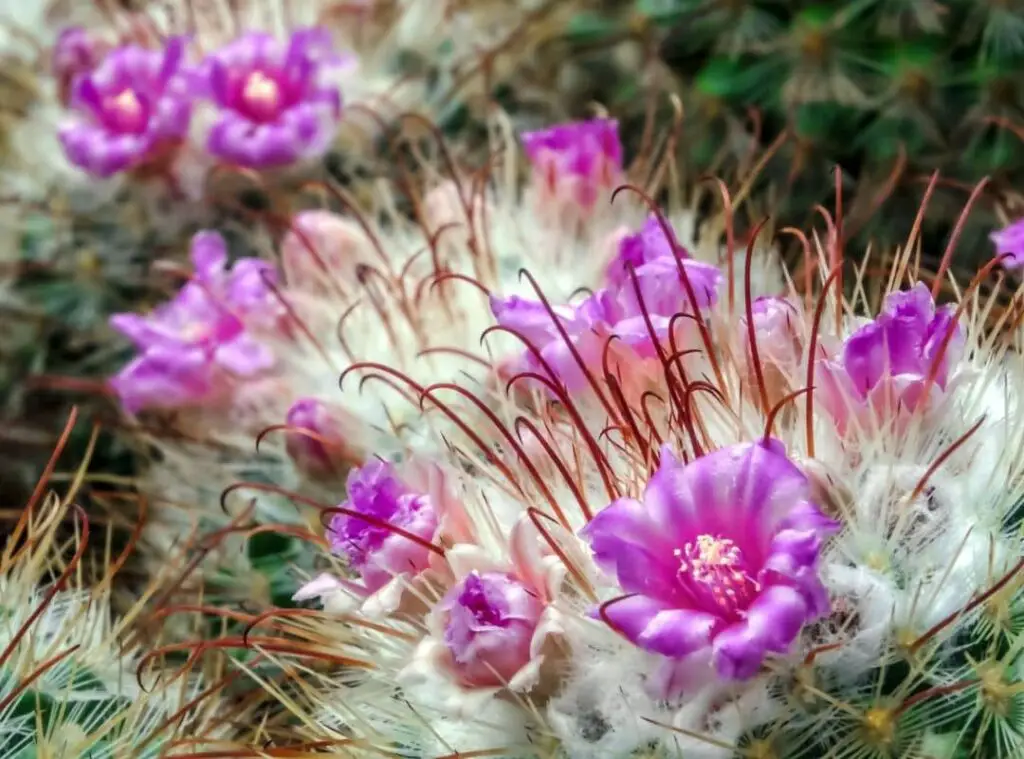
Pot size Potting and Repotting
Repotting and selecting a pot to grow Mammillaria bombycina is also very important in terms of taking care of them.
Apart from that, you should consider repotting them which will consequently help for a proper growth of the plant.
When selecting a pot, ensure that you are using a porous pot which has enough draining holes.
In terms of repotting, you need to consider repotting them once you spot them outgrown from the pots.
Generally you could repot them once every two years. Having said that if you repot them, once every year, it will allow you to observe the cactus roots and you could treat them if you find any damaged parts of the cactus.
Apart from that, it would also help you to provide a fresh soil mix which would be enriched with fresh nutrients for the Mammillaria bombycina.
Consequently, vigorous plant growth would also be benefited from that. Before repotting, you should always allow the soil to dry first and then proceed with repotting.
When the soil is dry, it would allow you to take off the plant easily.
Once you take it out, get rid of the old soil first. Next you should remove the rotted or dead roots. Moreover, you could consider treating them with a fungicide.
When you placed the plant in the new pot, let it dry for about a weeks’ time and after that you could commence watering them lightly.
Where to Plant
You need to grow them in a fast-draining soil mix. Apart from that you could consider adding perlite, pumice or even coarse sand and mix them at a ratio of 1:1. If you wish to have a bigger Mammillaria bombycina, you could consider growing them in garden soil.
Having said that, you could do this only if you have warmer winter conditions only. Otherwise, you will have to shift it indoors during winter.
In addition to that, you need to plant them in a place where Mammillaria bombycina would get full sunlight which will make this cactus a perfect fit for outdoors.
If you wish to grow it indoors, place it somewhere it gets proper sunlight and ideally it has to be a place like a sunny windowsill.
On the other hand, if you are going through any heatwave, I would urge you to shift the plant to a shady place so that it will not expose to intense heat waves.
Fertilizer and time of year
When it comes to fertilizing the Mammillaria bombycina, it is not very important. Having said that, it would be useful for theප when you consider fertilizing on a long-term.
To do that, you could consider using a slow-release fertilizer. Instead of that, you could use a specially formulated fertilizer for cactus as well.
You could feed them once every fortnight during their active growing season. Skip feeding them during winter though.
Dormancy
Mammillaria bombycina are winter dormant plants.
Can it be toxic to pets
Mammillaria bombycina are nontoxic plants.
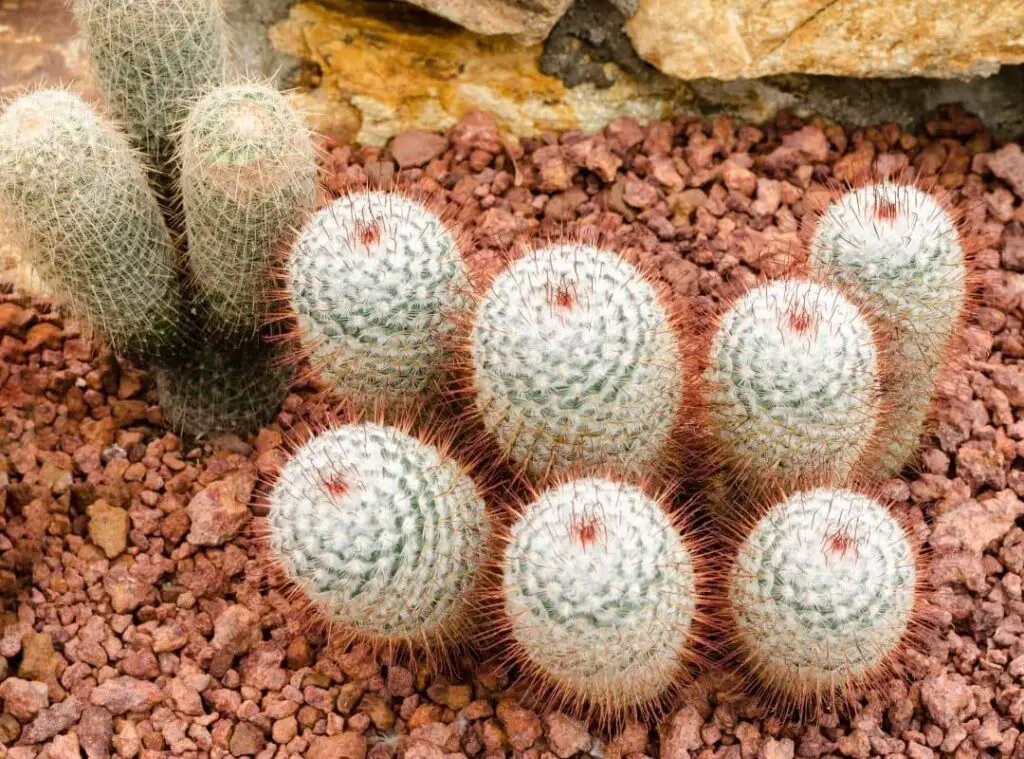
Common bugs and problems
Mammillaria bombycina would deteriorate if you expose them to excess moisture conditions. That would lead to fungal diseases and root rot as well.
Special Care tips
You should water the Mammillaria bombycina moderately whilst ensuring that soil is dry before you water them.
Avoid over watering them since they are tolerant of drought conditions. Consider feeding them as explained above.
How do you propagate a Mammillaria bombycina?
You could easily propagate the Mammillaria bombycina through seeds and from offsets. When it comes to propagation through offsets, you could simply pluck them from the mother plant.
When you do this, make sure that you do not harm the plant. The best is to wear gloves when you are doing this.
Once you take them off, you should allow those offsets to become callous for a few days. Next, you could plant them in a well-draining soil mix.
If you wish to propagate the Mammillaria bombycina through seeds, best is to conduct it in spring.
I would recommend using a cacti mix filled flat for this purpose. To do that, you could sow the seeds on the soil mix and cover them lightly with sand.
Keep the top layer in a moist condition and place it in a warm place. Best is to place them in a place where it gets a temperature less than 21 degrees Celsius.
Keep watering them lightly so that those seeds would not wither.
Read more about Mammillaria propagation : Pincushion Cactus Propagation Guide | 10 Minutes Quick Read |
Mammillaria bombycina plant benefits
You could grow them as decorative plants which you could keep in window sills. Further you could use them for dish gardens as well.
Not only that but also you could consider growing them as ground plants as well. Finally you could use them as container plants too.
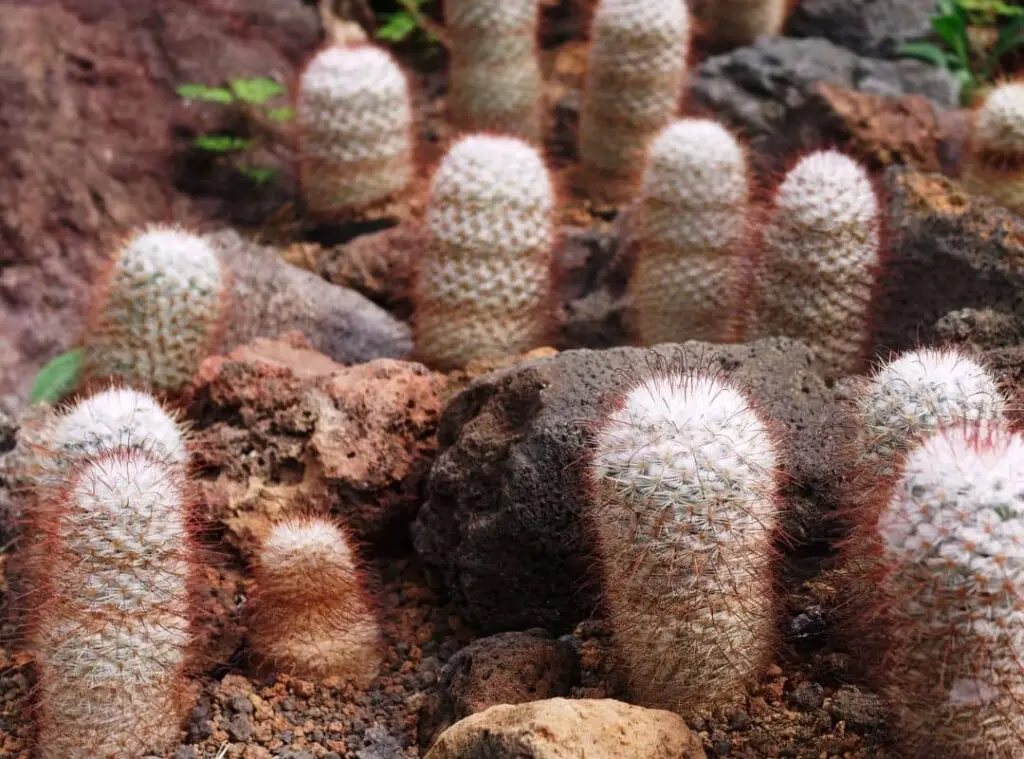
Related questions
Is Mammillaria bombycina an indoor plant?
You could grow Silken pincushion cactus as indoor plants. Having said that, if you wish to have a big Silken pincushion cactus, you should grow them outdoors.
Do Mammillaria bombycina need direct sunlight?
Silken pincushion cactus would prefer to have a lot of sunlight, but it does not need to be direct sunlight.
Can Mammillaria bombycina be rooted in water?
You could consider rooting the Silken pincushion cactus in water.
Should I mist my Mammillaria bombycina?
You could consider misting the Silken pincushion cactus occasionally, particularly during the winter season when you do not water them.
When you spot the soil is dry, you could consider misting them lightly.
Read More: Mammillaria Microthele Care | 15 Facts You Must Consider |
